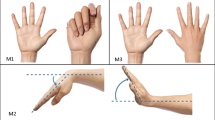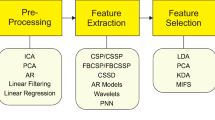Abstract
The motor imagery brain–computer interface (MI-BCI) provides an interactive control channel for spinal cord injury patients. However, the limitations of feature extraction algorithms may lead to low accuracy and instability in decoding electroencephalogram (EEG) signals. In this study, we examined the classification performance of an MI-BCI system by focusing on the distinction of the left and right foot kinaesthetic motor imagery tasks in five subjects. Feature extraction was performed using the common space pattern (CSP) and the Tikhonov regularisation CSP (TRCSP) spatial filters. TRCSP overcomes the CSP problems of noise sensitivity and overfitting. Moreover, support vector machine (SVM) and linear discriminant analysis (LDA) were used for classification and recognition. We constructed four combined classification methods (TRCSP-SVM, TRCSP-LDA, CSP-SVM, and CSP-LDA) and evaluated them by comparing their accuracies, kappa coefficients, and receiver operating characteristic (ROC) curves. The results showed that the TRCSP-SVM method performed significantly better than others (average accuracy 97%, average kappa coefficient 0.91, and average area under ROC curve (AUC) 0.98). Using TRCSP instead of standard CSP improved accuracy by up to 10%. This study provides insights into the classification of EEG signals. The results of this study can aid lower limb MI-BCI systems in rehabilitation training.
Graphical Abstract





Similar content being viewed by others
References
Attallah O, Abougharbia J, Tamazin M, Nasser AA (2020) A BCI system based on motor imagery for assisting people with motor deficiencies in the limbs. Brain Sci 10:864. https://doi.org/10.3390/brainsci10110864
Kraus D, Naros G, Bauer R et al (2016) Brain–robot interface driven plasticity: distributed modulation of corticospinal excitability. Neuroimage 125:522–532. https://doi.org/10.1016/j.neuroimage.2015.09.074
Simon C, Bolton DAE, Kennedy NC et al (2021) Challenges and opportunities for the future of brain-computer interface in neurorehabilitation. Front Neurosci 15:1–8. https://doi.org/10.3389/fnins.2021.699428
Bhattacharyya S, Konar A, Tibarewala DN (2014) A differential evolution based energy trajectory planner for artificial limb control using motor imagery EEG signal. Biomed Signal Process Control 11:107–113. https://doi.org/10.1016/j.bspc.2014.03.001
Wang X, Lu H, Shen X et al (2021) Prosthetic control system based on motor imagery. Comput Methods Biomech Biomed Eng 0:1–8 https://doi.org/10.1080/10255842.2021.1977800
Ono Y, Wada K, Kurata M, Seki N (2018) Enhancement of motor-imagery ability via combined action observation and motor-imagery training with proprioceptive neurofeedback. Neuropsychologia 114:134–142. https://doi.org/10.1016/j.neuropsychologia.2018.04.016
Liang S, Choi K-S, Qin J et al (2016) Improving the discrimination of hand motor imagery via virtual reality based visual guidance. Comput Methods Programs Biomed 132:63–74. https://doi.org/10.1016/j.cmpb.2016.04.023
Rahman MA, Khanam F, Ahmad M, Uddin MS (2020) Multiclass EEG signal classification utilizing Rényi min-entropy-based feature selection from wavelet packet transformation. Brain Informatics 7:1–11. https://doi.org/10.1186/s40708-020-00108-y
Mohamed AMA, Uçan ON, Bayat O, Duru AD (2020) Classification of resting-state status based on sample entropy and power spectrum of electroencephalography (EEG). Appl Bionics Biomech 2020:1–10. https://doi.org/10.1155/2020/8853238
Kim C, Sun J, Liu D et al (2018) An effective feature extraction method by power spectral density of EEG signal for 2-class motor imagery-based BCI. Med Biol Eng Comput 56:1645–1658. https://doi.org/10.1007/s11517-017-1761-4
Khalaf A, Sejdic E, Akcakaya M (2019) Common spatial pattern and wavelet decomposition for motor imagery EEG-fTCD brain-computer interface. J Neurosci Methods 320:98–106. https://doi.org/10.1016/j.jneumeth.2019.03.018
Chacon-Murguia MI, Olivas-Padilla BE, Ramirez-Quintana J (2020) A new approach for multiclass motor imagery recognition using pattern image features generated from common spatial patterns. SIViP 14:915–923. https://doi.org/10.1007/s11760-019-01623-0
Aldea R, Fira M (2014) Classifications of motor imagery tasks in brain computer interface using linear discriminant analysis. International Journal of Adv Res Artif Intell 3:5–9.https://doi.org/10.14569/IJARAI.2014.030702
Shen X, Wang X, Lu S, et al (2022) Research on the real-time control system of lower-limb gait movement based on motor imagery and central pattern generator. Biomed Signal Process Control 71:102803 https://doi.org/10.1016/j.bspc.2021.102803
Djoufack Nkengfack LC, Tchiotsop D, Atangana R, et al (2020) EEG signals analysis for epileptic seizures detection using polynomial transforms, linear discriminant analysis and support vector machines. Biomed Signal Process Control 62:102141 https://doi.org/10.1016/j.bspc.2020.102141
Petersen J, Iversen HK, Puthusserypady S (2018) Motor imagery based brain computer interface paradigm for upper limb stroke rehabilitation. In: 2018 40th Annual International Conference of the IEEE Engineering in Medicine and Biology Society (EMBC). IEEE, pp 1960–1963. https://doi.org/10.1109/EMBC.2018.8512615
Rani Alex JS, Haque MA, Anand A et al (2020) A deep learning approach for robotic arm control using brain-computer interface. Int J Biol Biomed Eng 14:128–135 https://doi.org/10.46300/91011.2020.14.18
Fu R, Han M, Tian Y, Shi P (2020) Improvement motor imagery EEG classification based on sparse common spatial pattern and regularized discriminant analysis. J Neurosci Methods 343:108833 https://doi.org/10.1016/j.jneumeth.2020.108833
Shuaibu Z, Qi L (2020) Optimized DNN classification framework based on filter bank common spatial pattern (FBCSP) for motor-imagery-based BCI. Int J Comput Applic 175:16–25. https://doi.org/10.5120/ijca2020920646
AnaP C, JakobS M, HelleK I, Puthusserypady S (2018) An adaptive CSP filter to investigate user independence in a 3-class MI-BCI paradigm. Comput Biol Med 103:24–33. https://doi.org/10.1016/j.compbiomed.2018.09.021
Tang Z, Li C, Wu J et al (2019) Classification of EEG-based single-trial motor imagery tasks using a B-CSP method for BCI. Front Inform Technol Electron Eng 20:1087–1098. https://doi.org/10.1631/FITEE.1800083
Lu, Z., Zhang X et al (2022) An asynchronous artifact-enhanced electroencephalogram based control paradigm assisted by slight facial expression. Front neurosci 16:892794 https://doi.org/10.3389/fnins.2022.892794
Zhang, X., Lu Z et al (2021) Realizing the application of EEG modeling in BCI classification: based on a conditional GAN converter. Front Neurosci 15:727394 https://doi.org/10.3389/fnins.2021.727394
Jin J, Miao Y, Daly I et al (2019) Correlation-based channel selection and regularized feature optimization for MI-based BCI. Neural Netw 118:262–270. https://doi.org/10.1016/j.neunet.2019.07.008
Wang Z, Yu Y, Xu M et al (2019) Towards a hybrid BCI gaming paradigm based on motor imagery and SSVEP. Int J Hum-Comput Interact 35:197–205. https://doi.org/10.1080/10447318.2018.1445068
Lotte F, Guan C (2011) Regularizing common spatial patterns to improve BCI designs: unified theory and new algorithms. IEEE Trans Biomed Eng 58:355–362. https://doi.org/10.1109/TBME.2010.2082539
Ghumman MK, Singh S, Singh N, Jindal B (2021) Optimization of parameters for improving the performance of EEG-based BCI system. J Reliable Intell Environ 7:145–156. https://doi.org/10.1007/s40860-020-00117-y
Li Y, Koike Y (2011) A real-time BCI with a small number of channels based on CSP. Neural Comput Appl 20:1187–1192. https://doi.org/10.1007/s00521-010-0481-6
Jusas S (2019) Classification of motor imagery using a combination of user-specific band and subject-specific band for brain-computer interface. Appl Sci 9:9–10. https://doi.org/10.3390/app9234990
Tariq M, Trivailo PM, Simic M (2019) Classification of left and right knee extension motor imagery using common spatial pattern for BCI applications. Procedia Comput Sci 159:2598–2606. https://doi.org/10.1016/j.procs.2019.09.256
Ling CX, Huang J, Zhang H (2003) AUC: a better measure than accuracy in comparing learning algorithms. In: Lecture Notes in Computer Science (including subseries Lecture Notes in Artificial Intelligence and Lecture Notes in Bioinformatics), pp 329–341. https://doi.org/10.1007/3-540-44886-1_25
Dagdevir E, Tokmakci M (2021) Truncation thresholds based empirical mode decomposition approach for classification performance of motor imagery BCI systems. Chaos Solitons Fractals 152:111450 https://doi.org/10.1016/j.chaos.2021.111450
Jia Ying Li;Li Zhao;Yan Bian (2021) Classification of lower limb motor imagination signals based on LDA and KNN. Foreign Electron Meas Technol 40:9–14. https://doi.org/10.19652/j.cnki.femt.2002388
Norizadeh Cherloo M, Kashefi Amiri H, Daliri MR (2021) Ensemble regularized common spatio-spectral pattern (ensemble RCSSP) model for motor imagery-based EEG signal classification. Comput Biol Med 135:104546 https://doi.org/10.1016/j.compbiomed.2021.104546
Funding
This work was supported by the National Natural Science Foundation of China (Nos. 81371663 and 61534003); the ‘Six Talents’ Peaks’ Project, China (No. SWYY-116); the ‘226 Engineering’ Research Project of Nantong Government; the Opening Project of State Key Laboratory of Bioelectronics, Southeast University; and the Postgraduate Research & Practice Innovation Program of Jiangsu Province, China (No. KYCX21_3085).
Author information
Authors and Affiliations
Corresponding author
Ethics declarations
Consent to participate
Before the experiment, all subjects signed the informed written consent and agreed to participate in this experiment.
Competing interests
The authors declare no competing interests.
Additional information
Publisher's note
Springer Nature remains neutral with regard to jurisdictional claims in published maps and institutional affiliations.
Rights and permissions
Springer Nature or its licensor (e.g. a society or other partner) holds exclusive rights to this article under a publishing agreement with the author(s) or other rightsholder(s); author self-archiving of the accepted manuscript version of this article is solely governed by the terms of such publishing agreement and applicable law.
About this article
Cite this article
Zhang, J., Wang, X., Xu, B. et al. An overview of methods of left and right foot motor imagery based on Tikhonov regularisation common spatial pattern. Med Biol Eng Comput 61, 1047–1056 (2023). https://doi.org/10.1007/s11517-023-02780-8
Received:
Accepted:
Published:
Issue Date:
DOI: https://doi.org/10.1007/s11517-023-02780-8




